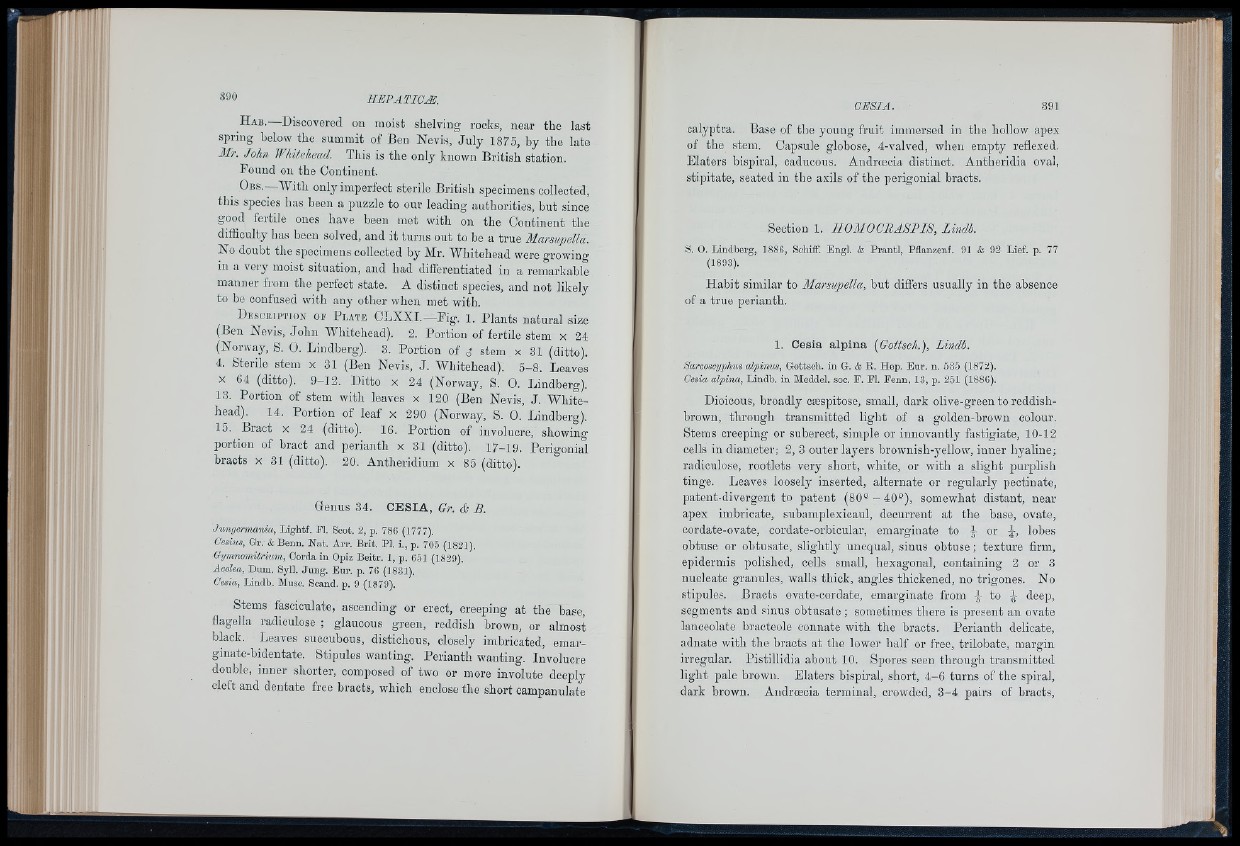
Hab. Discovered on moist shelving rocks, near the last
spring below the summit of Ben Nevis, July 1875, by the late
Mr. John Whitehead. This is the only known British station.
Found on the Continent.
Obs.—With only imperfect sterile British specimens collected,
this species has been a puzzle to our leading authorities, but since
good fertile ones have been met with on the Continent the
difficulty has been solved, and it turns out to be a true Marsupella.
No doubt the specimens collected by Mr. Whitehead were growing
in a very moist situation, and had differentiated in a remarkable
manner from the perfect state. A distinct species, and not likely
to be confused with any other when met with.
DESCRirTioN OE P l a t e CLXXL—Fig. 1. Plants natural size
(Ben Nevis, John Whitehead). 2. Portion of fertile stem x 24
(Norway, S. 0. Lindberg). 3. Portion of 8 stem x 31 (ditto).
4. Sterile stem x 31 (Ben Nevis, J. Whitehead). 5- 8. Leaves
X G4 (ditto). 9-12. Ditto x 24 (Norway, S. 0. Lindberg).
13. Portion of stem with leaves x 120 (Ben Nevis, J. Whitehead).
14. Portion of leaf x 290 (Norway, S. 0. Lindberg).
15. Bract x 24 (ditto). 16. Portion of involucre, showing
portion of bract and perianth x 31 (ditto). 17-19. Perigonial
bracts x 31 (ditto). 20. Antheridium x 85 (ditto).
Genus 34. CESIA, Gr. d Ji.
Jungermania, Lightf. Fl. Scot. 2, p. 786 (1777).
Cesius, Gr. ife Benn. Nat. Arr. Brit. PI, i., p. 705 (1821).
Ggmnomiirium, Gorda in Opiz Beitr. 1, p. 651 (1829).
Acolea, Bum. Syll. Ju n g . Eur. p. 76 (1831).
Cesia, Lindb. Muse. Scand. p. 9 (1879).
Stems fasciculate, ascending or erect, creeping at the base,
flagella radiculose ; glaucous green, reddish brown, or almost
black. Leaves suooubous, distichous, closely imbricated, emarginate
bidentate. Stipules wanting. Perianth wanting. Involucre
double, inner shorter, composed of two or more involute deeply
cleft and dentate free bracts, which enclose the short campanulate
calyptra. Base of tbe young fruit immersed in the hollow apex
of the stem. Capsule globose, 4-valved, when empty reflexed,
Elaters hispiral, caducous. Androecia distinct. Antheridia ova!,
stipitate, seated in the axils of the perigonial bracts.
Section 1 . H0M0CBA8P18, Lindb.
S. 0 . Lindberg, 1886, Schiff. Engl, it P ran tl, Pflanzenf. 91 ifc 92 Lief. p. 77
(1893).
Habit similar to Marsupella, but differs usually in the absence
of a true perianth.
1 . Cesia alpina (Gottsch.), Lindb.
Sarcoscyphus alpinus, Gottsch. in G. & E. Hop. Eur. n. 535 (1872).
Cesia alpina, Lindb. in Meddel. soc. F. Fl, Fenn. 13, p. 251 (l886).
Dioicous, broadly cæspitose, small, dark olive-green to reddish-
brown, through transmitted light of a golden-brown colour.
Stems creeping or suberect, simple or innovantly fastigiate, 10-12
cells in diameter; 2, 3 outer layers brownish-yellow, inner hyaline;
radiculose, rootlets very short, white, or with a slight purplish
tinge. Leaves loosely inserted, alternate or regularly pectinate,
patent-divergent to patent (80° - 40°), somewhat distant, near
apex imbrioate, subamplexioaul, decurrent at the base, ovate,
cordate-ovate, cordate-orbicular, emarginate to | or lobes
obtuse or obtusate, slightly unequal, sinus obtuse ; texture firm,
epidermis polished, cells small, hexagonal, containing 2 or 3
nucleate granules, walls thick, angles thickened, no trigones. No
stipules. Bracts ovate-cordate, emarginate from 1 to J deep,
segments and sinus obtusate ; sometimes there is present an ovate
lanceolate bracteole connate with the bracts. Perianth delicate,
adnate with the bracts at the lower half or free, trilobate, margin
irregular. Pistillidia about 10. Spores seen through transmitted
light pale brown. Elaters bispiral, short, 4-6 turns of the spiral,
dark brown. Androecia terminal, crowded, 3-4 pairs of bracts,